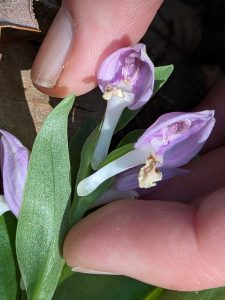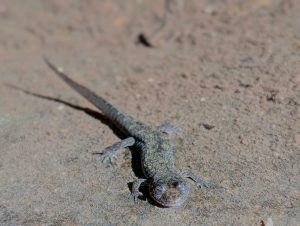
Every time I make the 500-mile trek north to my childhood home, I feel the tug of forgotten familiarity—the grassy backyard extending to a forest that’s roughly the same age as me, my grandfather’s nature photography hanging on the wall behind the kitchen table, the smell of home cooking, wooden floors, and years of intermingled lives I encounter nowhere else.

Springtime in the Smokies elicits similar emotions. After months of cold days, bare trees, and brown forest floors, the onset of spring induces a powerful longing to believe once again in the impossible: rainbows of blooms, carpets of green, extravagant abundance of life. This year, a cold winter gave way to a busy spring, so by the time mid-April rolled around I was elated by the opportunity to spend a few sunny workdays in Townsend, Tennessee, witnessing this miracle in real time.
After arriving, my first stop was an afternoon walk on Middle Prong Trail to search for long-lost signs of life—and they weren’t hard to find. Long-spurred violet, two-leaved toothwort, wake robin, and gem-like shafts of showy orchis all erupted along the trailside. There was also squirrel corn, foamflower, wild ginger, blue cohosh, and, peering up from a puddle along the Middle Prong of the Little River, a big-eyed dusky salamander. With each find, I felt a pleasurable wave of déjà vu for similar moments, in other springs. And, too often, a twinge of disappointment that species names I’d known so well by the end of last season now lay hidden in the dusty corners of my mind.
It reminded me of the way, on one of those visits back to my hometown, I might encounter some once-familiar face while sitting in a restaurant seat or church sanctuary, the name attached to it evading recall in that awkward moment of hello. It would come to me afterward, of course, and that person would occupy more of my thoughts over the next two days than in the past 20 years combined. In every third stranger, I’d see their face.

I returned from that hike up Middle Prong with a phone full of photos and an urge to resurrect the wildflower knowledge with which I’d ended spring 2024. Back in my hotel room, I uploaded the images to iNaturalist and bemoaned the fact that I’d forgotten to pack my copy of Wildflowers of the Smokies. So I let the algorithm offer suggestions, sighing various iterations of “Oh, I knew that!” when the IDs popped up.
Luckily, the colorful faces of spring offer ample opportunity for a forgetful acquaintance to obtain redemption. See one trillium plant, and you’re likely to find another one close by. Spot that first squirrel corn flower, and moments later you’ll realize there’s a whole patch of them just ten feet up the path. Find yourself befuddled by an identification on one trail, and odds are decent you might find the same species on another—if you know where to look.
After work the next day I set out on Schoolhouse Gap Trail, where a cathedral-like peace fell from the shade of long shadows and new leaves. I walked briskly, keeping pace to complete the hike before sundown, but admired each bloom as I passed, their names coming to me with increasing ease the longer I walked. By the end of the hike, we were well on our way to becoming reacquainted.

It was a good warm-up for the next day’s event, a hike up Chestnut Tops Trail with wildflower aficionado Tom Harrington. Harrington, a Volunteer-In-Park of 25 years who has been learning wildflowers for over four decades, knows far more on the topic than I’ve ever had the opportunity to forget. During the growing season, he’s out at least once a week engaging in the pastime he’s dubbed “wildflowering,” defined as “searching for, finding, and enjoying wildflowers.”
In the winter, he tells me, he holes up with his field guides, keeping his skills sharp while seeds and rhizomes wait dormant in the cold ground. The fruits of his dedication are evident. Out on Chestnut Tops Trail, Harrington identifies each flower without hesitation, stopping every time we encounter a new species to name it, admire it, and, sometimes, smell it.
For Harrington, the flowers are like old friends, and the Great Smoky Mountains akin to a hometown he never left. I may have been away for a while, but as we ascend the trail, I’m glad to find that I’m once more on a first-name basis with the locals.



Subscribe to get the latest posts sent to your email.
The Great Smokies Welcome Center is located on U.S. 321 in Townsend, TN, 2 miles from the west entrance to Great Smoky Mountains National Park. Visitors can get information about things to see and do in and around the national park and shop from a wide selection of books, gifts, and other Smokies merchandise. Daily, weekly, and annual parking tags for the national park are also available.